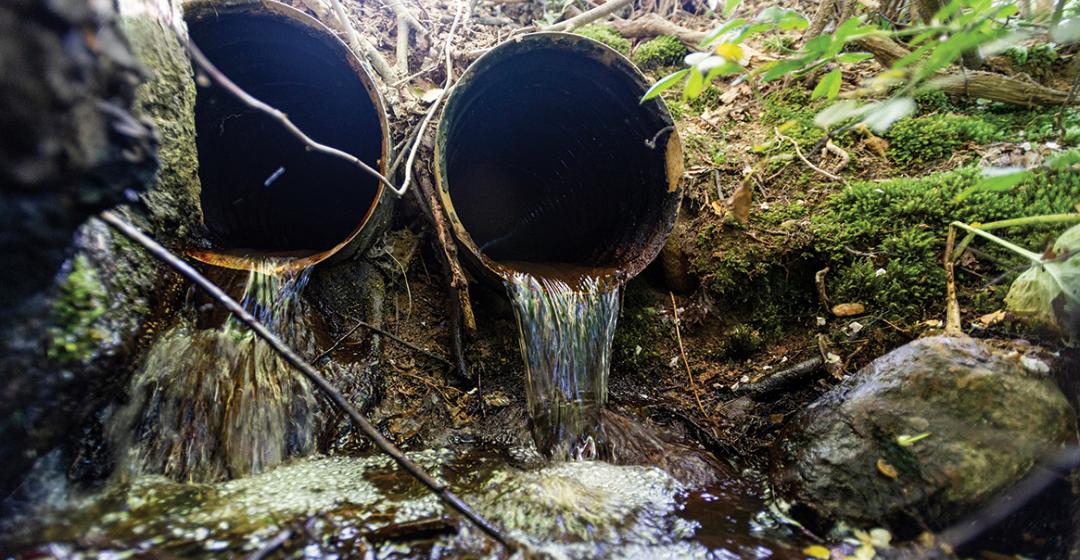Life’s not easy for the eastern brook trout, American eel, American brook lamprey, and a host of other creatures that live in Mill Brook. Dams, impoundments, and restrictive culverts fetter the ribbon of fresh water that flows from headwaters in Chilmark to Tisbury Great Pond in West Tisbury.
Sheriff’s Meadow Foundation, Martha’s Vineyard’s largest nonprofit private conservation organization, in partnership with the Massachusetts Division of Ecological Restoration, wants to remove one of the first links in a chain of obstacles, detailed in the Mill Brook Watershed Study Report along the brook’s four-mile course.
The Mill Brook Headwaters Restoration Project on Sheriff’s Meadow’s twenty-six-acre Roth Woodlands in Chilmark would replace two undersized, improperly sited corrugated steel culverts set under Old Farm Road fifty years ago with a concrete box culvert that meets state stream-crossing standards for maintaining habitat connectivity and preparing for climate change.
Adam Moore, Sheriff’s Meadow executive director, says a 2012 presentation by the Sea Run Brook Trout Coalition about the detrimental effects of obsolete dams and poorly designed culverts inspired the project. A $40,000 grant from the Massachusetts Environmental Trust got the permitting process started.
“We wanted to do our part, as a conservation organization and landowner along the Mill Brook, to help the brook and the fish and wildlife trying to live there,” Moore says. “We’re not an advocacy organization, but we believe that we should try to do our part on the lands we care for.”
The Massachusetts Division of Ecological Restoration, which designates projects that “bring significant ecological and community benefits to the Commonwealth” as a “high priority,” jumped on board. Director Beth Lambert says her agency selected the project “because of the importance of Mill Brook as a cold-water habitat, the ecological benefits of the project to Mill Brook, and the capacity of Sheriff’s Meadow Foundation to lead and support the project.”
Lambert says that headwater habitats, such as the Roth Woodlands site off North Road, are particularly important. “The impoundment formed by the undersized culverts heats up, threatening sensitive cold-water species in the brook such as eastern brook trout and stream lamprey,” she says. “As that hot water spills from the impoundment, it flows downstream, further impacting Mill Brook habitat. Restoring the headwaters not only benefits species that rely on headwaters streams, but also helps habitat further downstream.”
The Nature Conservancy, Mass Audubon, and the Massachusetts Office of Coastal Zone Management have endorsed the project’s environmental benefits.
Eight years and counting, Moore can be forgiven if he feels like a herring battling up the fish ladder at the foot of Mill Pond. By his own admission, he moved slowly to acquire state permits in an effort to buy time to assuage the concerns of the immediate abutters. Three years after the Massachusetts Executive Office of Energy and Environmental Affairs approved the project in April 2016, Sheriff’s Meadow filed an application in February 2019 with the Massachusetts Department of Environmental Protection (DEP) for a waterways license, the last step in the state approval process.
Abutters, in letters to the DEP, have sharply questioned Sheriff’s Meadow’s conclusions that restoring stream flow will benefit wildlife but will not affect area wells, which is what they fear.
Siblings Frank, Peter, and Heidi Dunkl have lived on the adjoining downstream twenty-three acres since the early 1960s. For years, they bottled and sold water from their well, registered as a DEP public water supply. Frank Dunkl has been the most vociferous opponent to the culvert project. In a recent telephone conversation and in his most recent letter to Sheriff’s Meadow, dated May 12, 2020, he reiterated his concerns that none of the agencies or consultants that support the project, no matter how prestigious their names, has completed any on-site analysis over a period of time. Based on his close observation of the property for more than fifty years, he wrote, “the existing culverts have served well, and there is no need to replace them.”
The Dunkl property is owned by Island Grown Initiative, a nonprofit dedicated to agriculture, food advocacy, and education on the Vineyard. It bought the land in 2013 for $1.5 million under an arrangement that gives the Dunkls the lifetime right to live on and control it. In a letter to the DEP dated May 21, 2020, Island Grown executive director Rebecca Haag echoed many of Dunkl’s concerns, including possible impacts on the registered public-water source. The nonprofit seeks “absolute assurances and financial protection that our property will not be damaged by this project,” the letter concluded.
Abutter Thomas Bena expressed concern for his family’s well and went so far as to accuse Sheriff’s Meadow of duplicity. In a letter dated May 8, 2020, to the DEP he said, “The fact that this is all happening as we undergo a worldwide pandemic only adds to the feeling that not only is this not neighborly, it is not appropriate or honest.”
Pending DEP approval, the project, which has yet to be funded, is expected to go before the Chilmark Conservation Commission this fall.
Stream restoration efforts are taking place across Massachusetts, often with immediate results, as in nearby Falmouth where herring have returned to the Coonamessett River. Set against the sea of permitting and cost challenges that would be required to restore Mill Brook to its natural state as an unimpeded cold water stream, the culvert is a mere trickle. But it is a first step.
Lambert says the Mill Brook restoration project is an opportunity to demonstrate to Island residents and visitors the benefits of habitat restoration for people and nature.
“Every successful river restoration project leads to increased interest in restoration, frequently catalyzing other projects elsewhere in the community or the watershed,” she says. “Each project makes the next one easier.”





